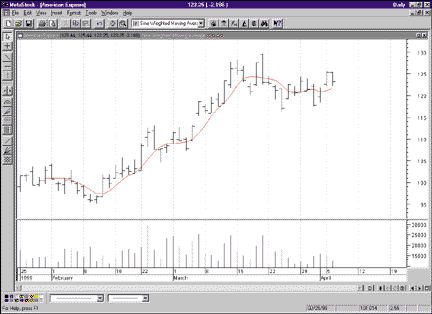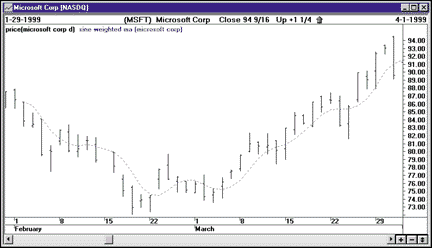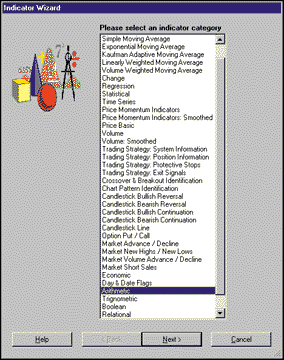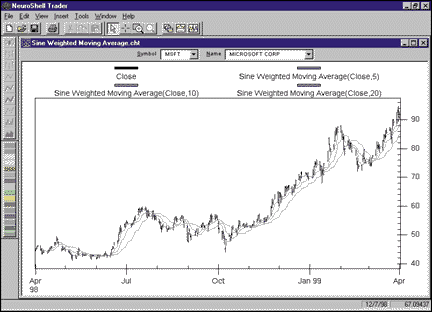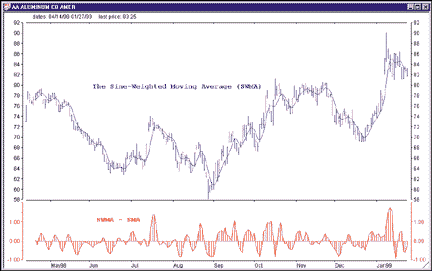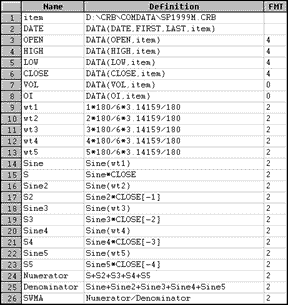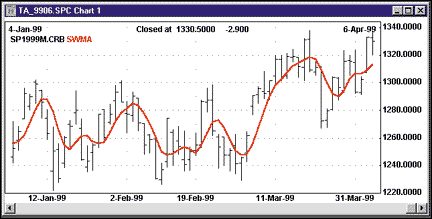In the May 1998 issue of STOCKS & COMMODITIES, a Traders' Tip provided MetaStock formulas for calculating support and resistance levels and the WRO and WSO support and resistance oscillators. The Traders' Tip was based on my article, "Automated Support And Resistance," also in that issue. Since then, I've received many E-mail messages from STOCKS & COMMODITIES readers about it.
While the method was well received, the formulas provided were a bit confusing and could use some clarification. Further, execution was slow and screening of large numbers of stocks was difficult. Since then, I have developed a faster and improved method for computing these indicators.
To begin, the support levels S1 through S6 and the resistance levels R1 through R6 are separate indicators (12 in all), and each should be entered using the custom indicator option in the indicator builder.
S1 Indicator:
ValueWhen(1, Ref(L,-4) = LLV(L,9), Ref(L,-4))
S2 Indicator:
ValueWhen(2, Ref(L,-4) = LLV(L,9), Ref(L,-4))
S3 Indicator:
ValueWhen(3, Ref(L,-4) = LLV(L,9), Ref(L,-4))
S4 Indicator:
ValueWhen(4, Ref(L,-4) = LLV(L,9), Ref(L,-4))
S5 Indicator:
ValueWhen(5, Ref(L,-4) = LLV(L,9), Ref(L,-4))
S6 Indicator:
ValueWhen(6, Ref(L,-4) = LLV(L,9), Ref(L,-4))
R1 Indicator:
ValueWhen(1, Ref(H,-4) = HHV(H,9), Ref(H,-4))
R2 Indicator:
ValueWhen(2, Ref(H,-4) = HHV(H,9), Ref(H,-4))
R3 Indicator:
ValueWhen(3, Ref(H,-4) = HHV(H,9), Ref(H,-4))
R4 Indicator:
ValueWhen(4, Ref(H,-4) = HHV(H,9), Ref(H,-4))
R5 Indicator:
ValueWhen(5, Ref(H,-4) = HHV(H,9), Ref(H,-4))
R6 Indicator:
ValueWhen(6, Ref(H,-4) = HHV(H,9), Ref(H,-4))
These 12 indicators should be individually plotted with the price data as points, not lines (click on each and change the style to the one on the bottom of the style menu). The color red is recommended for the support levels S1 through S6 and the color blue for the resistance levels R1 through R6. Entering these formulas and changing the style takes a bit of time, but once done, they can be saved as a template and easily applied to another stock.
If you are interested only in computing the WRO and WSO indicators, then these formulas can be entered as shown here. It is not necessary to compute S1 through S6 or R1 through R6, since the new formulas are now self-contained. The new WRO and WSO formulas also contain max and min functions to ensure that the change for each level is either zero or 1. This avoids a rare but occasional error when the price change is very large over a short period.
WSO Indicator:
L1:=ValueWhen(1,Ref(L,-4)=LLV(L,9),Ref(L,-4));
L2:=ValueWhen(2,Ref(L,-4)=LLV(L,9),Ref(L,-4));
L3:=ValueWhen(3,Ref(L,-4)=LLV(L,9),Ref(L,-4));
L4:=ValueWhen(4,Ref(L,-4)=LLV(L,9),Ref(L,-4));
L5:=ValueWhen(5,Ref(L,-4)=LLV(L,9),Ref(L,-4));
L6:=ValueWhen(6,Ref(L,-4)=LLV(L,9),Ref(L,-4));
L1M:= Max(0,Min(1,Int(L1/C)));
L2M:= Max(0,Min(1,Int(L2/C)));
L3M:= Max(0,Min(1,Int(L3/C)));
L4M:= Max(0,Min(1,Int(L4/C)));
L5M:= Max(0,Min(1,Int(L5/C)));
L6M:= Max(0,Min(1,Int(L6/C)));
100*(1-(L1M+L2M+L3M+L4M+L5M+L6M)/6)
WRO Indicator:
L1:=ValueWhen(1,Ref(H,-4)=HHV(H,9),Ref(H,-4));
L2:=ValueWhen(2,Ref(H,-4)=HHV(H,9),Ref(H,-4));
L3:=ValueWhen(3,Ref(H,-4)=HHV(H,9),Ref(H,-4));
L4:=ValueWhen(4,Ref(H,-4)=HHV(H,9),Ref(H,-4));
L5:=ValueWhen(5,Ref(H,-4)=HHV(H,9),Ref(H,-4));
L6:=ValueWhen(6,Ref(H,-4)=HHV(H,9),Ref(H,-4));
L1M:= Max(0,Min(1,Int(L1/C)));
L2M:= Max(0,Min(1,Int(L2/C)));
L3M:= Max(0,Min(1,Int(L3/C)));
L4M:= Max(0,Min(1,Int(L4/C)));
L5M:= Max(0,Min(1,Int(L5/C)));
L6M:= Max(0,Min(1,Int(L6/C)));
100*(1-(L1M+L2M+L3M+L4M+L5M+L6M)/6)
The WRO and WSO oscillators are generally plotted together on a separate scale from the price plot. It is helpful to add horizontal lines at zero and 100 on this same scale. Horizontal lines can be added by clicking on the indicator and selecting "horizontal lines" from the Indicator Properties menu.
These formulas run much faster (by 40 times) than the earlier formulas, and theyÕve been tested successfully with both end-of-day data and real-time data using MetaStock Professional Version 6.51.
-- Mel Widner, Ph.D., 703 791-5910
E-mail techstrategies@msn.com
![]() METASTOCK 1
METASTOCK 1 ![]() METASTOCK 2
METASTOCK 2 ![]() TRADESTATION/SUPERCHARTS
TRADESTATION/SUPERCHARTS ![]() WINDOW ON WALLSTREET
WINDOW ON WALLSTREET ![]() NEUROSHELL TRADER
NEUROSHELL TRADER ![]() TECHNIFILTER PLUS
TECHNIFILTER PLUS ![]() SMARTTRADER
SMARTTRADER ![]() WAVE WI$E SPREADSHEET
WAVE WI$E SPREADSHEET
